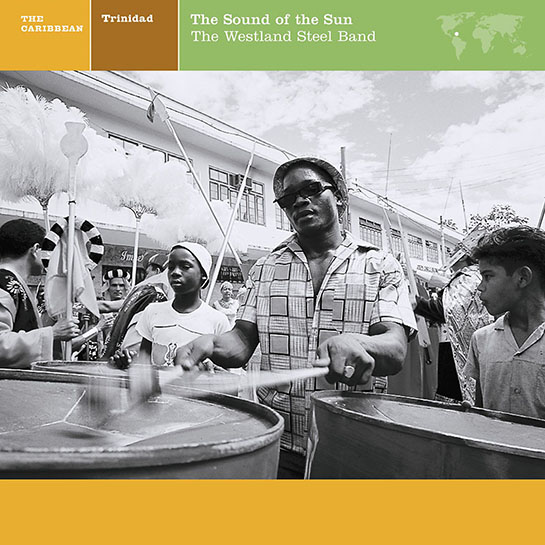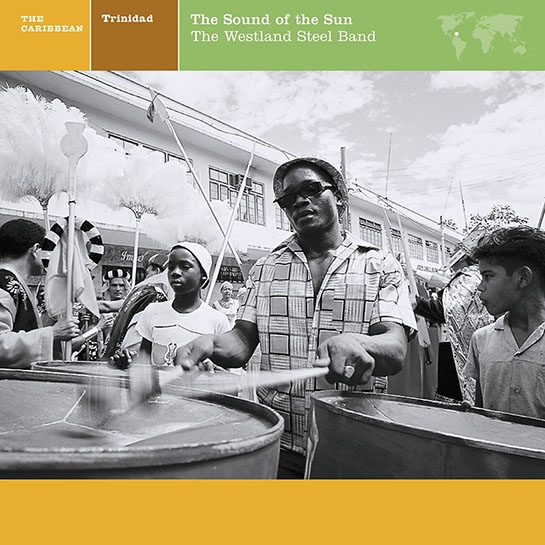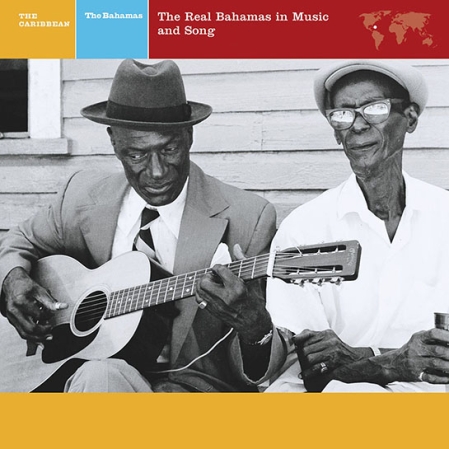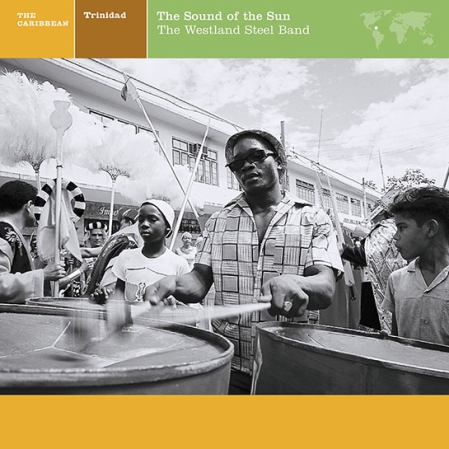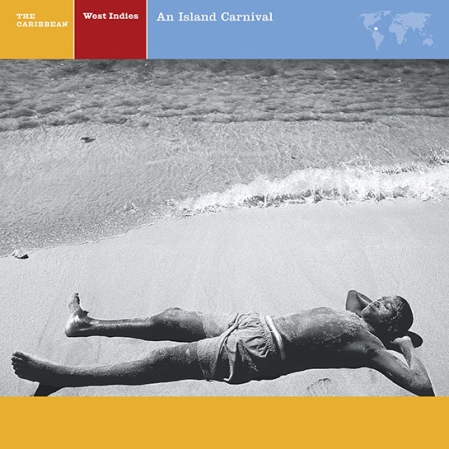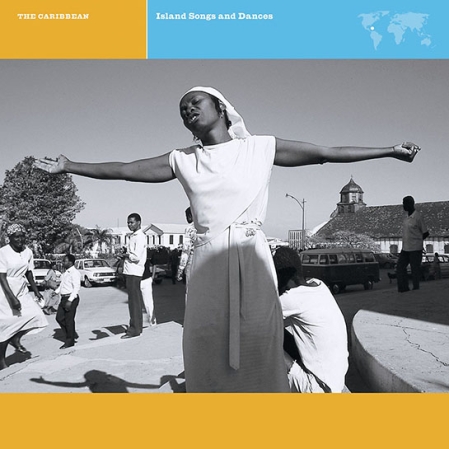A fairly recent innovation, the steel drum has become so firmly linked with West Indies, it is often thought to be a traditional instrument of the region. This album features The Westland Steel Band of Trinidad performing a collection of songs associated with Carnival, the pre-Lenten festivities that annually engulf the island in a wave of music and dance.
In order to provide a historical context for this recording, the liner notes that accompanied its original release have been reprinted in full. —Ed.
Light slides off the sea onto city streets. Streets alive with all the people of Trinidad. Yellow beams catch in silver and crimson spangles of costumes. The sun reflects the laughing, dancing, hand-reaching, voice-touching release of an island in the midst of Carnival. Red-suited officials pick the prettiest girl, the most elaborate costume; contests are held to find the best song, the best dancer, the best band. Over, around, beneath it all the sea, the sun, the sound of the steel bands.
Carnival was carried to Trinidad in the late 1700s by French planters who had enjoyed the pre-Lenten festivities on other West Indian islands. It was an almost sedate, upper-class celebration imitated, in secret, and most unsedately, by slaves “behind Big House.”
Carnival burst from its staid routine with the freeing of the slaves in 1837. Masks allowed action without fear of reprisal. Bands grew larger and louder. Songs were purposely lewd and pointedly anti-upper-class.
The French planters were horrified. Police tried to squelch Carnival with little success. To halt some of the excesses, official controls were inaugurated—thus the organized contests.
The original slave celebrations had moved to the beat of the conga drums—the same drums used in religious rituals to summon believers to worship and gods to receive sacrifices. The official church, as part of its drive to eliminate “foreign” religions, outlawed the drums. But no celebration in Trinidad works right without rhythm. “Bamboo tamboo” stick bands were devised to fill the musical gap. The bands were hundreds of young people, each carrying a bamboo pole, nine to eleven inches thick and four to six feet long. A deep hollow sound, varying with the size of the bamboo, was made by pounding the open end of the stick on the ground. Rhythmic effects were carefully rehearsed—the streets thundered at the sun.
In 1937 the stick bands were outlawed. Marchers had given up pounding the ground and started pounding each other—and the police. The police were effective in silencing the bands. Once more Carnival was threatened with the lack of rhythm. Not only Carnival, but the “music personalities” of the two major population groups on the island, the freed African slaves and the imported Indian laborers, demanded rhythm.
Improvisation of instruments carried Carnival for a year or so. First partially filled bottles, struck with spoons, provided the music. Then it was found that better, mostly louder, effects could be obtained by using metal. Any piece of metal would do. Two men carried a car axle while two others pounded on it with tin cans. Kitchens were raided for cooking pots and metal spoons; junkyards were combed for brake drums and oil containers. Melody was impossible, harmony unheard of, but the steel band sound had begun.
There are countless rumors, calypsos, and stories telling of the One man, the thousand One men who first discovered that dents in the tops of the steel drums made notes—notes which could be repeated at will. Experiments with the size and depth of the dents led to a system of controlling pitch and tone. The large oil industry on the island gave a ready source of basic instruments. There are now thousands of steel drummers, pan men, in the hundreds of bands of the island. The rest of the Caribbean has adopted the instrument—bands have been formed in England, Australia, Greece, the Orient, the United States. Steel drum bands have developed into recognized orchestras.
Four basic types of drums form the steel band: the ping pong (soprano), the guitar pan (alto), the cello pan (tenor), and the boom (bass). The only non-metal instrument used is the shac-shac, a gourd filled with seeds. The number of notes on a pan, the face of the drum, can vary from 32 on the ping pong to two on the boom. To create a scale on the metal barrels, the bung end is cut off, the bottom is heated, and separate segments of different depths and sizes are hammered out. The resulting instrument is not really a drum but a tuned gong struck with sticks wrapped in rubber strips.
When the band marches, the melody is carried by one instrument at a time while the other band members are free to play variations on a theme. The melody transfers from instrument to instrument down the streets. The sound is liquid—the sound of the sun on the sea, the sea against sand, feet marching through streets that hold sparkling heat and the hearts of an entire island.
-JANE SARNOFF, 1967
PRODUCTION CREDITS
Originally released in 1967
Recorded and Produced by Bill Leader
Production Supervisor: Peter K. Siegel
Mastered by Robert C. Ludwig
Coordinator: Teresa Sterne
Re-mastered by Robert C. Ludwig
Design: Doyle Partners
Cover Photograph: © Ian Berry / Magnum Photos
79726
MUSICIANS
The Westland Steel Band
